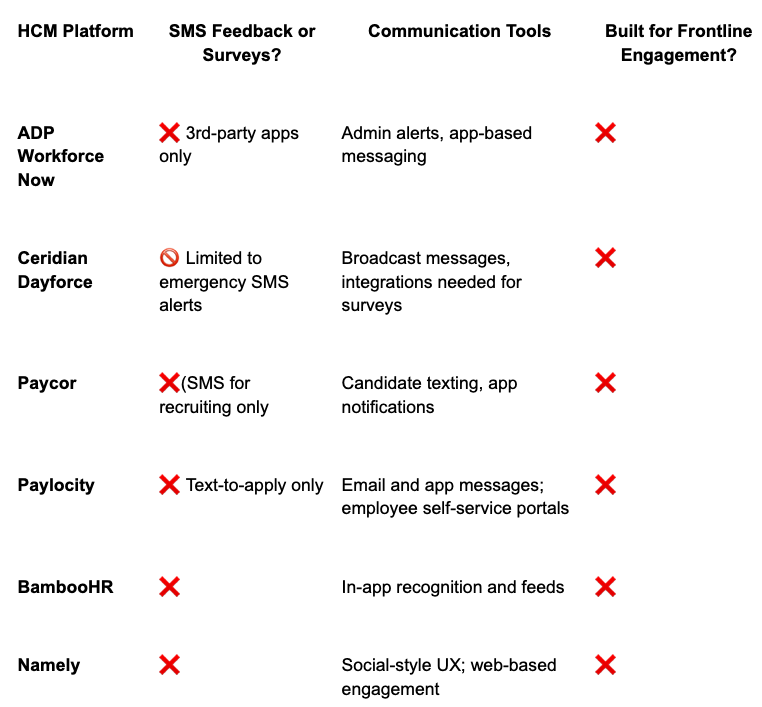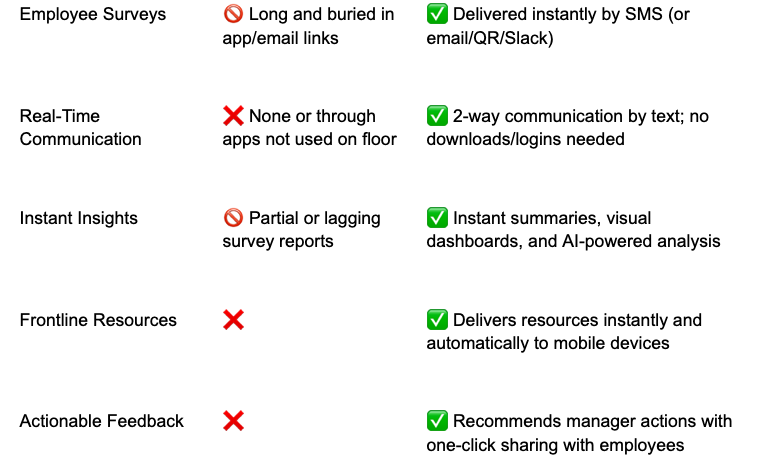
Most companies invest heavily in Human Capital Management (HCM) platforms to centralize payroll, onboarding, performance tracking, and basic HR functions. And they should. These systems are foundational to a compliant, well-run organization.
But increasingly, businesses with remote, deskless or frontline workforces are discovering a critical gap: traditional HCMs weren’t built to engage employees who are working remotely, are in the field, on the floor and on tight shifts and don’t check emails or log into apps during the day. As a result, these workers often feel disconnected, unheard, and unengaged—leading to turnover, mistakes, and operational inefficiencies that HCMs can’t solve.
Below are two stories from companies that thought their HCMs were enough—until real-world issues showed otherwise.
Warehouse Operations Breakdown—Despite a Modern HCM
A mid-sized logistics company with multiple warehouses across the Midwest had implemented a well-known HCM platform to streamline HR operations. The system handled payroll, benefits, and compliance reporting seamlessly. Managers were trained to use the self-service tools, and employees were encouraged to access the mobile app to check schedules and complete onboarding tasks.
But on the warehouse floor, reality looked different.
Employees rarely downloaded the app, and when they did, they forgot their login credentials or found the interface to be not very intuitive. Many frontline workers didn’t have a company email address, and few checked personal emails during or between shifts. Important HR announcements and feedback requests went unread.
Supervisors were frustrated. Despite using the HCM to send policy reminders and employee surveys, they received minimal responses. Engagement was low, training compliance fell short of expectations, and employees reported feeling “out of the loop.”
Turnover climbed steadily. Exit interviews revealed that new hires felt unsupported and unrecognized during their first 30 days. Some cited “lack of communication” or “no one asked for my input” as key reasons for leaving.
Over the next year, the company saw:
- A 32% increase in turnover, especially among new hires
- Delays in fulfilling orders due to untrained replacements
- A rise in customer complaints about packing errors and delivery mistakes
The HCM did its job—but it wasn’t built to reach the people actually doing the work, in real time, in their environment.
Missed Signals on the Manufacturing Floor
At a growing U.S. manufacturer with four plants and over 800 employees, leadership invested in a top-rated HCM to manage operations across states. The software tracked hours, processed payroll, and allowed digital access to HR documents and benefits enrollment.
From a systems perspective, everything was humming along.
But job delays were mounting. Quality issues were creeping into production reports. And engagement scores—measured via annual surveys delivered through email—were declining.
Plant supervisors had no quick way to check in with crew members during or between shifts. Email wasn’t effective. The HCM had a messaging feature, but it lived inside the company portal—rarely accessed by the average line worker.
When one production region consistently underperformed, leadership initiated a series of focus groups. That’s when they learned that employees had long-standing frustrations about inconsistent instructions, delayed maintenance responses, and unclear job roles. No one had asked.
The company’s internal “job delay board”—a whiteboard logging interruptions—showed a 40% spike over the previous quarter. Many of the logged issues could have been avoided with timely communication and clarification. Instead, they snowballed into costly downtime.
In the end, the company realized that while their HCM was great for payroll and paperwork, it was nearly invisible on the floor.
Why Companies Think Their HCM Is Enough (But It’s Not)
The HCM (Human Capital Management) platforms like ADP, Paylocity, or BambooHR are crucial for payroll, benefits, and compliance—but they’re not designed to help you engage your workforce, especially if that workforce is largely on the frontline and/or deskless.
In fact, over 80% of the global workforce is deskless, including people working in manufacturing, construction, logistics, retail, and healthcare. Yet according to a recent study, only 1% of software funding goes toward building tools for this group.
HCMs might have an employee portal or a mobile app, but if your employees aren’t checking emails or logging into apps on the job, those features don’t deliver engagement and might as well be invisible to this population.
Let’s Break It Down: 6 Popular HCMs
Here’s what each of the top mid-tier HCMs offers when it comes to frontline communication and feedback:

Bottomline is while there is a lot riding on these platforms and they are each very useful for their intended uses. None of them are built to regularly connect with frontline and deskless workers in warehouses, job sites, retail stores, or factory floors who are typically on tight shifts and don’t use apps or email at work.
Why Engaging Frontline and Deskless Employees Is So Hard
Frontline and deskless workers face unique barriers that traditional HCMs don't account for:
1. Limited Access to Communication Tools
Most deskless workers don’t sit at desks or check email. They often don’t download or log into company apps either. This makes communication via portals or notifications ineffective. According to a recent study, 45% of deskless workers have no access to workplace technology at all.
2. Busy and Inflexible Schedules
Frontline employees like factory floor workers, truck drivers, restaurant workers, and warehouse teams work on strict shifts with little downtime. Stopping to check notifications or read emails just isn’t realistic and does not work in their environment.
Without the ability to reach these employees in the moment and on their mobile devices, companies are left guessing about what’s really going on—and missing opportunities to improve.
What You Need to Complement (Not Replace) Your HCM
Alongside your HCM, you need a tool to enhance your existing systems by bridging the communication gap between leadership and the frontline.
Here are the functions you need:


Tools like Trivvy work alongside your HCM to ensure that employee voices don’t get lost—especially the ones you can’t afford to ignore: your warehouse operators, line workers, machine technicians, and drivers.
A Better Approach to Employee Engagement
Let’s return to the case studies.
- In the warehouse case, it wasn’t better benefits or faster payroll that stabilized the workforce—it was real-time communication and feedback that met people where they were: on their phones, during their shifts or at shift breaks.
- In the manufacturing company, operations didn’t improve because of better scheduling software—they improved because of quick updates and micro-surveys that got to the root of issues before they impacted production.
Trivvy didn’t replace their systems. It was a powerful complement to the existing systems that engaged workers to voice their inputs and feel heard, and also provided real-time insights instantly to the leadership for decision making and targeted actions.
Final Thoughts: Don’t Let Your HCM Be the End of the Story
Your HCM is a vital foundation—but it wasn’t built for the realities of your frontline teams. If you want to:
- Lower turnover
- Improve quality and throughput
- Reduce errors and delays
- Close the engagement gap
- Empower your frontline managers
You need more than payroll and self-service apps. You need a true communications and feedback tool that meets your workers where they are and delivers the insights and recommended actions that your supervisors need.
Trivvy is the first feedback and communication platform primarily designed for the people doing the actual work—and it works alongside your HCM to help your business run better from the ground up.
Image credit: Photo by Unsplash under license.
__________________________________________________________________________________
For more discussion on this topic see our Linkedin post.
For related News, Tips and Tricks, see here.
__________________________________________________________________________________
###
Trivvy is a text-based survey and communications tool (no links or logins required). Trivvy goes beyond results; it provides instant follow-up recommendations tailored to your organization. To find out more and try Trivvy for free, click here.
You can also check out this one-minute Trivvy video.


Experience the Difference with Trivvy
Trivvy is more than just a survey tool; it’s a comprehensive solution designed to meet the needs of frontline workers and organizational leaders alike. By streamlining and enhancing communication, Trivvy helps you build a more connected and engaged workforce.




